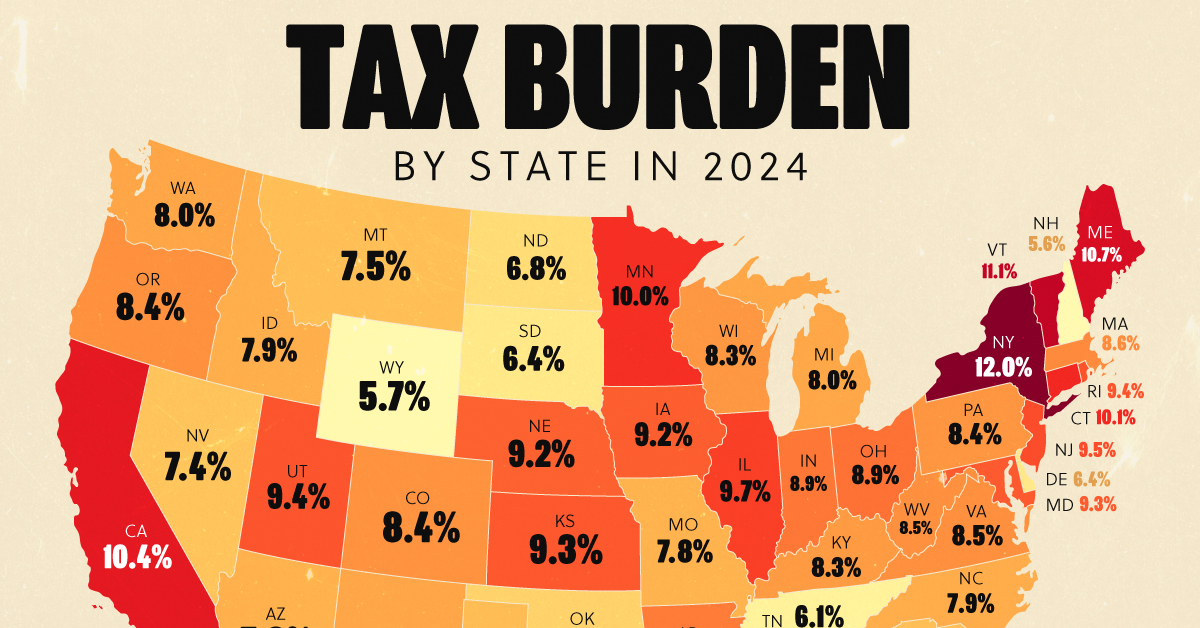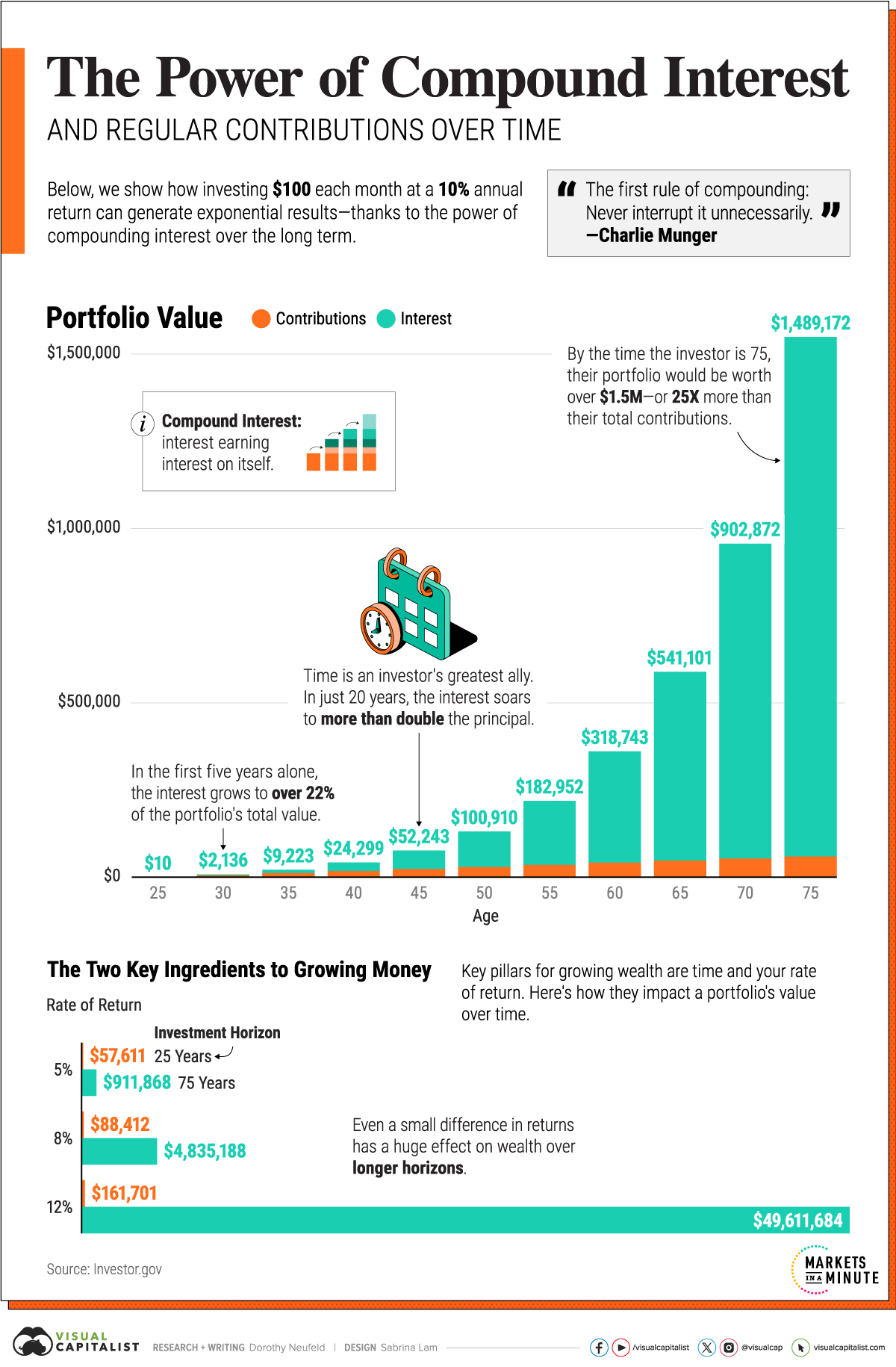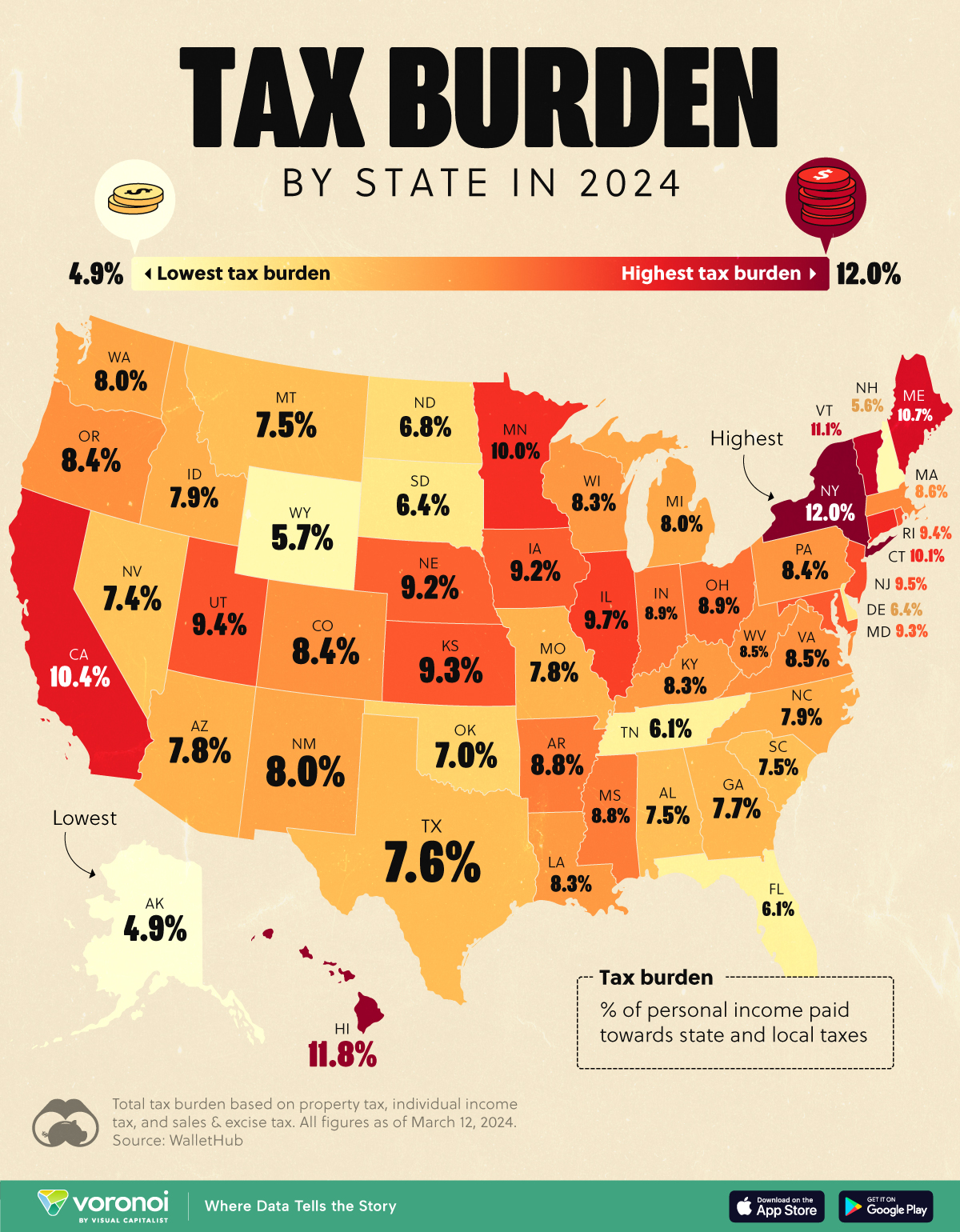Money
How Small Investments Make a Big Impact Over Time
![]() See this visualization first on the Voronoi app.
See this visualization first on the Voronoi app.
How Small Investments Make a Big Impact Over Time
This was originally posted on our Voronoi app. Download the app for free on iOS or Android and discover incredible data-driven charts from a variety of trusted sources.
Time is an investor’s biggest ally, even if they start with just a modest portfolio.
The reason behind this is compounding interest, of course, thanks to its ability to magnify returns as interest earns interest on itself. With a fortune of $159 billion, Warren Buffett largely credits compound interest as a vital ingredient to his success—describing it like a snowball collecting snow as it rolls down a very long hill.
This graphic shows how compound interest can dramatically impact the value of an investor’s portfolio over longer periods of time, based on data from Investor.gov.
Why Compound Interest is a Powerful Force
Below, we show how investing $100 each month, with a 10% annual return starting at the age of 25 can generate outsized returns by simply staying the course:
| Age | Total Contributions | Interest | Portfolio Value |
|---|---|---|---|
| 25 | $1,300 | $10 | $1,310 |
| 30 | $7,300 | $2,136 | $9,436 |
| 35 | $13,300 | $9,223 | $22,523 |
| 40 | $19,300 | $24,299 | $43,599 |
| 45 | $25,300 | $52,243 | $77,543 |
| 50 | $31,300 | $100,910 | $132,210 |
| 55 | $37,300 | $182,952 | $220,252 |
| 60 | $43,300 | $318,743 | $362,043 |
| 65 | $49,300 | $541,101 | $590,401 |
| 70 | $55,300 | $902,872 | $958,172 |
| 75 | $61,300 | $1,489,172 | $1,550,472 |
Portfolio value is at end of each time period. All time periods are five years except for the first year (Age 25) which includes a $100 initial contribution. Interest is computed annually.
As we can see, the portfolio grows at a relatively slow pace over the first five years.
But as the portfolio continues to grow, the interest earned begins to exceed the contributions in under 15 years. That’s because interest is earned not only on the total contributions but on the accumulated interest itself. So by the age of 40, the total contributions are valued at $19,300 while the interest earned soars to $24,299.
Not only that, the interest earned soars to double the value of the investor’s contributions over the next five years—reaching $52,243 compared to the $25,300 in principal.
By the time the investor is 75, the power of compound interest becomes even more eye-opening. While the investor’s lifetime contributions totaled $61,300, the interest earned ballooned to 25 times that value, reaching $1,489,172.
In this way, it shows that investing consistently over time can benefit investors who stick it through stock market ups and downs.
The Two Key Ingredients to Growing Money
Generally speaking, building wealth involves two key pillars: time and rate of return.
Below, we show how these key factors can impact portfolios based on varying time horizons using a hypothetical example. Importantly, just a small difference in returns can make a huge impact on a portfolio’s end value:
| Annual Return | Portfolio Value 25 Year Investment Horizon | Portfolio Value 75 Year Investment Horizon |
|---|---|---|
| 5% | $57,611 | $911,868 |
| 8% | $88,412 | $4,835,188 |
| 12% | $161,701 | $49,611,684 |
With this in mind, it’s important to take into account investment fees which can erode the value of your investments.
Even the difference of 1% in investment fees adds up over time, especially over the long run. Say an investor paid 1% in fees, and had an after-fee return of 9%. If they had a $100 starting investment, contributed monthly over a 25-year time span, their portfolio would be worth over $102,000 at the end of the period.
By comparison, a 10% return would have made over $119,000. In other words, they lost roughly $17,000 on their investment because of fees.
Another important factor to keep in mind is inflation. In order to preserve the value of your portfolio, its important to choose investments that beat inflation, which has historically averaged around 3.3%.
For perspective, since 1974 the S&P 500 has returned 12.5% on average annually (including reinvested dividends), 10-Year U.S. Treasury bonds have returned 6.6%, while real estate has averaged 5.6%. As we can see, each of these have outperformed inflation over longer horizons, with varying degrees of risk and return.
Wealth
Visualizing the Tax Burden of Every U.S. State
Tax burden measures the percent of an individual’s income that is paid towards taxes. See where it’s the highest by state in this graphic.

Visualizing the Tax Burden of Every U.S. State
This was originally posted on our Voronoi app. Download the app for free on iOS or Android and discover incredible data-driven charts from a variety of trusted sources.
This map graphic visualizes the total tax burden in each U.S. state as of March 2024, based on figures compiled by WalletHub.
It’s important to understand that under this methodology, the tax burden measures the percent of an average person’s income that is paid towards state and local taxes. It considers property taxes, income taxes, and sales & excise tax.
Data and Methodology
The figures we used to create this graphic are listed in the table below.
| State | Total Tax Burden |
|---|---|
| New York | 12.0% |
| Hawaii | 11.8% |
| Vermont | 11.1% |
| Maine | 10.7% |
| California | 10.4% |
| Connecticut | 10.1% |
| Minnesota | 10.0% |
| Illinois | 9.7% |
| New Jersey | 9.5% |
| Rhode Island | 9.4% |
| Utah | 9.4% |
| Kansas | 9.3% |
| Maryland | 9.3% |
| Iowa | 9.2% |
| Nebraska | 9.2% |
| Ohio | 8.9% |
| Indiana | 8.9% |
| Arkansas | 8.8% |
| Mississippi | 8.8% |
| Massachusetts | 8.6% |
| Virginia | 8.5% |
| West Virginia | 8.5% |
| Oregon | 8.4% |
| Colorado | 8.4% |
| Pennsylvania | 8.4% |
| Wisconsin | 8.3% |
| Louisiana | 8.3% |
| Kentucky | 8.3% |
| Washington | 8.0% |
| New Mexico | 8.0% |
| Michigan | 8.0% |
| North Carolina | 7.9% |
| Idaho | 7.9% |
| Arizona | 7.8% |
| Missouri | 7.8% |
| Georgia | 7.7% |
| Texas | 7.6% |
| Alabama | 7.5% |
| Montana | 7.5% |
| South Carolina | 7.5% |
| Nevada | 7.4% |
| Oklahoma | 7.0% |
| North Dakota | 6.8% |
| South Dakota | 6.4% |
| Delaware | 6.4% |
| Tennessee | 6.1% |
| Florida | 6.1% |
| Wyoming | 5.7% |
| New Hampshire | 5.6% |
| Alaska | 4.9% |
From this data we can see that New York has the highest total tax burden. Residents in this state will pay, on average, 12% of their income to state and local governments.
Breaking this down into its three components, the average New Yorker pays 4.6% of their income on income taxes, 4.4% on property taxes, and 3% in sales & excise taxes.
At the other end of the spectrum, Alaska has the lowest tax burden of any state, equaling 4.9% of income. This is partly due to the fact that Alaskans do not pay state income tax.
Hate Paying Taxes?
In addition to Alaska, there are several other U.S. states that don’t charge income taxes. These are: Florida, Nevada, South Dakota, Tennessee, Texas, Washington, and Wyoming.
It’s also worth noting that New Hampshire does not have a regular income tax, but does charge a flat 4% on interest and dividend income according to the Tax Foundation.
Learn More About Taxation From Visual Capitalist
If you enjoyed this post, be sure to check out this graphic which ranks the countries with the lowest corporate tax rates, from 1980 to today.
-

 Markets6 days ago
Markets6 days agoThe World’s Fastest Growing Emerging Markets (2024-2029 Forecast)
-

 Technology2 weeks ago
Technology2 weeks agoAll of the Grants Given by the U.S. CHIPS Act
-

 Green2 weeks ago
Green2 weeks agoThe Carbon Footprint of Major Travel Methods
-

 United States2 weeks ago
United States2 weeks agoVisualizing the Most Common Pets in the U.S.
-

 Culture2 weeks ago
Culture2 weeks agoThe World’s Top Media Franchises by All-Time Revenue
-

 Visual Capitalist1 week ago
Visual Capitalist1 week agoBest Visualizations of April on the Voronoi App
-

 Wealth1 week ago
Wealth1 week agoCharted: Which Country Has the Most Billionaires in 2024?
-

 Markets1 week ago
Markets1 week agoThe Top Private Equity Firms by Country















